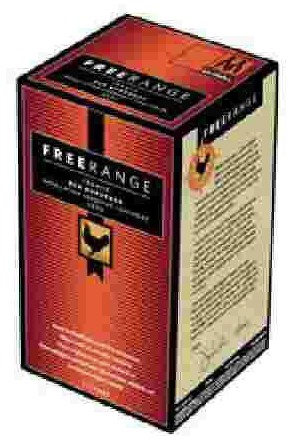Nine good friends,
five boxes of California Pinot Grigio
in plain brown wrappers,
and one enormous pot of soup


The theme of today's
Wine Blogging Wednesday #31 (Box Wines and Non-Traditional Packaging) offered a great excuse to seek out some of the more interesting top-end boxed wines on the market. And we did seek; but alas, we did not find.
I am often able to find interesting boxed wines when I travel, but I've done no travelling this month. So we shopped locally, but unfortunately, here at the end of the road in this coastal backwater which we call home, there was not much of great interest to be found.
I made some special requests of my local wine merchant, Wanda. She tried in vain to procure the
Dtour Macon-Villages Chardonnay, the
Cuvee de Pena from
Chateau Pena,
La Petit Frog Picpoul de Pinet from
Hugues Beaulieu,
Toad Hollow's
Le Faux Frog Pinot Noir, or anything surprising and new to me. But she struck out at every turn. She had even run out of a Cotes du Rhone 3L box which had been a staple in her shop for months.
Instead, I determined that I would create interesting experience of another sort out of a collection of boxed wines from the group which I refer to as the "usual suspects" (the Californian and Australian bag-in-box wines that can be purchased locally in the big-box stores and better supermarkets). Ultimately, at the eleventh hour, I purchased every brand of Pinot Grigio 3 liter box to be found within 50 miles, and sat down with eight friends to compare them. (I regret that I could not find the PG from Black Box Wines).
Five boxes of wine sat in a row on the counter, anonymously wrapped in brown paper. A great pot of Chicken and Artichoke Heart soup simmered on the stove. The crowd was quite an interesting assortment, including a couple of writers, a chef, a few carpenters, some self-proclaimed winos, and a retired professor of bio-psychology / sensory psychology from SUNY Albany who is, in short, an academic professional wine taster. The comparison of our varied individual opinions was even more interesting than the comparison of the wines themselves.
The five wines (in alphabetical order):
Corbett Canyon 2006 Pinot Grigio, $8.99. This wine pretty much tied for top pick among the group, much to the surprise of our attending expert, who placed it near the bottom of his list. Four members of the group picked this as the favorite, and four more as second favorite.
Positive comments: "like this one; more body; keeper" ... "good; favorite" ... "light & refreshing; slightly acidic" ... "a bit sweet; complex"
Negative comment:"no bouquet; light violet flavor; acidic; weak finish; NO (would not buy)"
Delicato 2005 Pinot Grigio, $17.99. This wine generally made the bottom of the list, with seven members of the group placing it as least or second to least favored. One of our tasters, however, rated it second pick.
Positive comment: "yes; keeper"
Negative comments: "no bouquet; flat to light flowery; no finish; NO (would not buy)" ... "not a lot of flavor" ..."yuck" ..."not much body or flavor"
FishEye 2005 Pinot Grigio, $16.20. This wine tied for top pick, being favorited 5 times (including by our expert), and chosen as second favorite twice.
Positive comments: "pretty good all around" ... "light bouquet; light apple & pear; nice finish; Good (would look for and buy)" ..."better; not as good as (Corbett Canyon)"
Negative comment: "little taste; loser"
Trove 2005 Pinot Grigio, $17.99. Solidly in the middle of the pack, but second favorite of our expert.
Positive comments: "applely; smooth; not much finish; but very drinkable" ... "slight flowery bouquet; raspberry; light melon finish; Good (would look for and buy)" ..."okay"
Negative comments: "too acidic; with a biting aftertaste; not very memorable" ..."weird; maybe"
Wine Cube 2005 Pinot Grigio, $15.99. Second to last overall, with no really strong opinions either way.
Positive comments: "not bad; yes; ok" ... "tart; astringent; acidic; nice wine; not too complex"
Negative comments: "a little sweet" ... "so so" ... "no bouquet; pear; bitter finish; OK minus (would buy but not pay much)"
Points in summary:
- The FishEye Pinot Grigio is deserving of the gold medal awarded to it in the 2007 SF Chronicle Wine Competition.
- Greatest group consensus often focuses around mediocrity.
- Many of our group will find great pleasure in the Corbett Canyon Pinot Grigio at half the price of any other wine in this field.
- Our noses, palates, preferences, and opinions are as varied as these wines. All are right and none are wrong. Even the expert taster and his wife (no inexperienced palate herself) flat-out panned eachother's top picks.
Perhaps we'll do this again. I'm thinking Shiraz next time.








